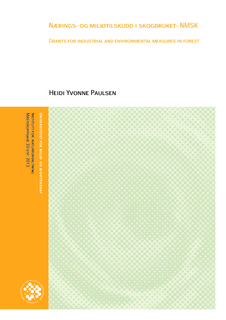| dc.description.abstract | Denne mastergradsoppgaven tar for seg utbetalt tilskudd til Nærings- og Miljøtiltak i
Skogbruket (NMSK) fra Fylkesmannen i ti fylker, og fra tjue kommuner i de aktuelle fylkene,
i årene 2007 og 2012. Tilskudd til nærings- og miljøtiltak i skogbruket er en tilskuddsordning
som skal stimulere til økt verdiskaping i skogbruket ut fra lokale og regionale prioriteringer,
og på samme tid ivareta og videreutvikle miljøverdier knyttet til biologisk mangfold,
landskap, kulturminner og friluftsliv. Vedtaksmyndigheten for NMSK-midlene er fordelt på
Fylkesmannen og kommunene (avsnitt 1.2.1.).
Hensikten med oppgaven var å finne ut hvordan fordelingen av tilskuddsmidler var mellom
miljø- og produksjonstiltakene på regionalt og lokalt nivå, hvorvidt NMSK-tilskuddene treffer
miljøutfordringene i skogbruket på en måte som er i tråd med intensjonen i Forskrift om
tilskudd til nærings- og miljøtilskudd i skogbruket, og om NMSK- virkemiddelet kan endres
slik at miljøverdier blir bedre ivaretatt i skogbruket.
Tilskuddene til vei utgjorde 85 % av samlede NMSK-midler fra Fylkesmannen i 2007, mens
drift med taubane, hest o.a. mottok 15 % av tilskuddspotten. I 2012 var fordelingen til
skogsveier og drift med taubane, hest o.a. på henholdsvis 62 % og 10 %. I 2009 ble tilskudd
til utdrift av skogsvirke til bioenergi (“flisordningen”) innført, og i 2012 ble 28 % av de totale
NMSK-midlene fra Fylkesmannen i de ti fylkene betalt ut til dette tiltaket. I både 2007 og 2012 ble det utbetalt svært lite penger til miljøtiltak i kommunene som inngikk
i denne oppgaven. Bare henholdsvis tre og seks av tjue kommuner betalte ut NMSK-tilskudd
til miljøtiltak i 2007 og 2012. Dette utgjorde 1 % av NMSK-midlene i de tjue kommunene
sammenlagt i 2007, og 4 % av midlene i 2012. Kompensasjon for ikke-hogst av
nøkkelbiotoper var det vanligste miljøtiltaket i de to årene oppgaven tar for seg. Tilskudd til
skogkultur utgjorde 79 % av de tjue kommunenes utbetalte NMSK-midler i 2007 og 91 % i
2012. De vanligste tiltakene innen feltet skogkultur var ungskogpleie, planting og
markberedning. Tilskuddsposten “andre tiltak og prosjekter” ble stort sett brukt til
pådriverprosjekter for fremme av tiltak innen skogkultur og skjøtsel.
Økt bruk av frivillig vern, bedre kartfesting i—og samordning av—databaser, NMSK-tilskudd
til miljøtiltak kun i årene rett etter at ny områdetakst foreligger. This master’s thesis aims to describe the different measures and the amount of money granted, in the
Grants for Industrial and Environmental Measures in Forest (Norwegian abbreviation: NMSK) in
Norwegian forestry. Ten counties (the Fylkesmann) and twenty municipalities were asked, through
telephone interviews and by e-mail, to state the exact amount of money—and measures to which—the
NMSK-grants were paid in the years 2007 and 2012. The NMSK grants system aims to encourage
greater added value in forestry, based on local and regional priorities, while at the same time
maintaining and developing environmental values associated with biodiversity, landscape values,
cultural heritage and recreation.
Both the Fylkesmann and the municipalities are administrative authorities for the NMSK grants
system (section 1.2.1.). The main purpose of the study was to determine whether or not the grants
were effective in developing and maintaining the environmental values in forestry in a way that is
consistent with the intent of the Regulations relating to Grants for Industrial and Environmental
Measures in Forest, and whether the grants system could be amended in such a way that
environmental issues may be better addressed in local forestry in the future.
The grants for forest roads represented 85 % of the total NMSK funds from the Fylkesmann in 2007,
whilst forestry driven by cable crane, horse etc. received 15 % of the grants from the Fylkesmann that
year. In 2012, the distribution was 62 % and 10 % respectively. In 2009 grants for forest products for
bioenergy were introduced, and in 2012 this measure received 28 % of the total grants from the
Fylkesmann. Environmental initiatives were granted little money in both of the two years: only three
and six municipalities paid any grants to environmental initiatives in 2007 and 2012, respectively. This
represented only 1 % of the NMSK funds from the twenty municipalities in 2007 and 4 % of the funds
in 2012. The most common of the environmental initiatives in the municipalities concerned was
compensation for non-logging in key habitats. Grants to regeneration and silviculture accounted for 79
% of the municipal NMSK funds in 2007 and 91 % in 2012. The most common silvicultural measures
were tending of young stands, planting and scarification. Grants to “other initiatives and projects”
were mostly spent on projects for the promotion of silvicultural activities and industrial forest
management.
Some of the suggestions for improvement for the NMSK grants system were: coordination and
improvement of computerized maps and databases containing information about important
environmental values in forest, dividing the NMSK grants system into an industrial grants fund and a
grants fund concerned with environmental measures in forest, to consider applying for grants for
voluntary conservation, or paying grants to environmental measures in forest only in the first few
years after new forestry plans become available. | no_NO |
